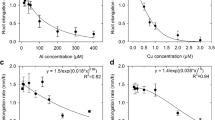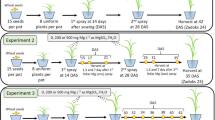Abstract
Root elongation in short-term experiments with wheat (Triticum aestivum L.) seedlings demonstrated that the following ions were rhizotoxic in the order Cu2+>Al 3+≫ H+>Zn2+≫ Na+. Additions of Ca2+ and Mg2+ alleviated the toxicity, but the relative ameliorative effectiveness of Ca2+ and Mg2+ depended upon the toxicant. The effectiveness of Mg2+ relative to Ca2+ was 0.098 for Na+, 0.37 for H+, 1.0 for Al3+, 2.1 for Cu2+, and 170 for Zn2+. The mechanisms of inhibition are mainly unknown, but the mechanisms of alleviation are better understood. Mechanism I entails ameliorant-induced reduction of the negativity of the plasma membrane (PM) surface electrical potential (ψ0). The consequence is a reduced activity of the toxicant at the PM surface because of reduced electrostatic attraction. Ca2+ and Mg2+ are equally effective agents of Mechanism I alleviation but are less effective than H+ and more effective than Na+ for reasons described by electrostatic principles. Mechanism II alleviation is specific for Ca2+ and entails the restoration of Ca2+ at the PM surface if surface Ca2+ has been reduced by the toxicant to growth-limiting levels. This occurs more commonly in Na+ and H+ toxicities than in the others, though in no case is it the principal mechanism of alleviation. Mechanism III alleviation is the collective ameliorative effect of an ion beyond Mechanisms I and II. Differences between Ca2+ and Mg2+ in ameliorative effectiveness are mainly attributable to Mechanism III which, in the case of Zn2+, may entail an internal detoxification and, in the case of Na+, may entail the blockade of a Na+ uptake channel. This study demonstrates that appropriate nonlinear equations incorporating cell-surface ion activities enable the dissection of multiple toxic and ameliorative effects of the ions.
Similar content being viewed by others
References
Alberts B, Bray D, Lewis J, Raff M, Roberts K and Watson J D 1989 Molecular Biology of the Cell, 2nd Ed. Garland Publishing, London.
Grauer U E and Horst W J 1990 Effect of pH and nitrogen source on aluminium tolerance of rye (Secale cereale L.) and yellow lupin (Lupinus luteus L.). Plant Soil 127, 13–21.
Kinraide T B 1998 Three mechanisms for the calcium alleviation of mineral toxicities. Plant Physiol. 118, 513–520.
Kinraide T B 1999 Interactions among Ca2+, Na+ and K+ in salinity toxicity: quantitative resolution of multiple toxic and ameliorative effects. J. Exp. Bot. 50, 1495–1505.
Kinraide T B 2001 Ion fluxes considered in terms of membrane-surface electrical potentials. Austral. J. Plant Physiol. 28, 605–616.
Kinraide T B, Yermiyahu U and Rytwo G 1998 Computation of surface electrical potentials of plant cell membranes. Correspondence to published zeta potentials from diverse plant sources. Plant Physiol. 118, 505–512.
Kinraide T B 2003 Toxicity factors in acidic forest soils. Attempts to evaluate separately the toxic effects of excessive Al3+ and H+ and insufficient Ca2+ and Mg2+ upon root elongation. Europ. J. Soil Sci. 54, 513–520.
Marschner H 1995 Mineral Nutrition of Higher Plants, 2nd Ed. Academic Press, London.
Parker D R, Pedler J F, Thomason D N and Li H 1998 Alleviation of copper rhizotoxicity by calcium and magnesium at defined free metal-ion activities. Soil Sci. Soc. Am. J. 62, 965–972.
Pedler J F, Kinraide T B, and Parker D R 2004 Zinc rhizotoxicity in wheat and radish is alleviated by micromolar levels of magnesium and potassium in solution culture. Plant Soil 259, 191–199.
Silva I R, Smyth T J, Israel D W, Raper C D and Rufty T W 2001a Magnesium is more efficient than calcium in alleviating aluminum rhizotoxicity in soybean and its ameliorative effect is not explained by the Gouy-Chapman-Stern model. Plant Cell Physiol. 42, 538–545.
Silva I R, Smyth T J, Israel D W, Raper C D and Rufty T W 2001b Magnesium ameliorates aluminum rhizotoxicity in soybean by increasing citric acid production and exudation by roots. Plant Cell Physiol. 42, 546–554.
Tyerman S D, Skerrett M, Garrill A, Findlay G P and Leigh R A 1997 Pathways for the permeation of Na+ and Cl− into protoplasts derived from the cortex of wheat roots. Plant Cell Physiol. 48, 459–480.
Yermiyahu U, Rytwo G, Brauer D K and Kinraide T B 1997 Binding and electrostatic attraction of lanthanum (La3+) and aluminum (Al3+) to wheat root plasma membranes. J. Membrane Biol. 159, 239–252.
Author information
Authors and Affiliations
Rights and permissions
About this article
Cite this article
Kinraide, T.B., Pedler, J.F. & Parker, D.R. Relative effectiveness of calcium and magnesium in the alleviation of rhizotoxicity in wheat induced by copper, zinc, aluminum, sodium, and low pH. Plant and Soil 259, 201–208 (2004). https://doi.org/10.1023/B:PLSO.0000020972.18777.99
Issue Date:
DOI: https://doi.org/10.1023/B:PLSO.0000020972.18777.99




